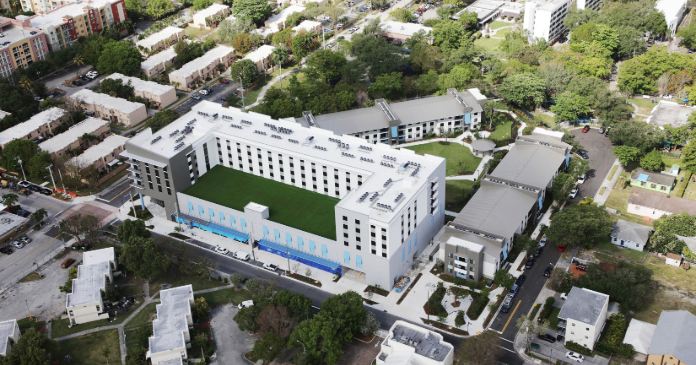Yield PRO TV presents NAHB Power Hitters. Host Linda Hoffman talks with Robert Freed, Chief Executive Officer of SummerHill Housing Group.
Transcript: NAHB Power Hitters interview. Linda Hoffman with Robert Freed, chief executive office of Summerhill Housing Group, recorded November 16, 2021
(music)
Linda Hoffman: The nation’s housing shortage marches on and California continues to lead the way. Housing is only one of the many painpoints facing this state. For the first time in more than a century, California recorded a net loss in population last year. This phenomenon was long in the making and the housing crisis was only one of the many stress points Californians face. California has transitioned from being the land of opportunity to become the land of regulation and control.
Still, lawmakers will quickly remind us that California is the world’s fifth largest economy and that tech is booming. After all, the state boasted an astounding $76 billion budget surplus in the midst of the pandemic. However, budget surpluses don’t reflect well-being—among California’s list of woes is the country’s top poverty rate. Also, California’s housing supply hasn’t kept up with demand for decades. The California Department of Housing and Community Development estimates that the state needs 180,000 new units annually to meet demand. Annual inventory growth is 80,000 leaving a shortfall of 100,000 units every year.
The housing problem is a drumbeat in the ears of everyone in the state. California Governor Gavin Newsom just signed new bills authorizing $22 billiom in new housing construction for an estimated 84,000 new housing units. Every little bit helps, I guess.
Today we speak to someone who can get to the heart of the matter, Robert Freed. Robert Freed is CEO of Summerhill Housing Group in San Ramon, California. Summerhill is an affiliate of Marcus and Millichap in Palo Alto. At present, Robert oversees 32 projects spanning over 5,000 units. Robert comes with quite the background including KB Homes, Davidon Homes and the Blackhawk Corporation.
Robert, welcome to the show.
Robert Freed: Thank you. Nice to be here.
Linda Hoffman: Robert, what’s the story? How did you land at Summerhill Housing Group?
Robert Freed: Well, I’ve known George Marcus for quite some time, and he is the major owner of Marcus Millichap and the Summerhill Housing Group. And, when I was at KB, as much as I enjoyed it, it came to me that I wanted to be more intimate with the business again, which meant getting back to the Bay Area, and focusing my attention primarily on the Bay Area. But, also get, sort of, in the trenches again, because I had, fortunately, risen to a fairly high executive level at KB, but that got you away from, you know, land acquisitions and entitlements and architecture. And I really enjoy that.
And so, George and I started talking, and one thing led to another, and 14 years later I’m still here having a good time.
Linda Hoffman: Summerhill focuses on infill development, primarily in the San Francisco Bay Area. You also build both rental and for-sale housing. What do you look for in a site—especially in differentiating between rentals and for-sale housing?
Robert Freed: What we are always looking to see, whether sites can accommodate both housing types. Naturally there are some pieces that are only going to be for housing, for-sale housing, others accommodate only for-rent. But when there’s an opportunity to do both, it gives us a competitive advantage because we can average out on the land cost, and, hopefully, make more attractive offers to potential sellers.
And also, in the Bay Area, often times, it will come in where there’s a minimum density level, say you have to hit 50 units to an acre. Well, you’re not going to do that on a for-sale piece. But if we can come in with an apartment building and townhomes, and meet that minimum, then we have a benefit that others can’t provide and that has led to a number of interesting transactions.
So that is the core of our strategy.
Linda Hoffman: What’s your secret sauce when scouting opportunity for in-fill development?
Robert Freed: Well, we’re teamed with some good professionals. We’ve been in the area for long time. Summerhill Homes has been, I think, in business for over 45 years. So, we’re known to brokers. We’re fortunately known to have a good reputation. We operate with our own equity, which gives us a big advantage. Most of our transactions, we option the land, take it through to entitlements, so, we are not looking for third-party equity to risk those dollars. That gives us a competitive advantage. And we have long-term relationships with sellers, and that has benefited us.
Lastly, I’d say, going back to the reputation. Some of our competitors are known to tie up transactions with a track record of renegotiating them at the end of it. We really try to do strong underwriting in the beginning, and meet our commitments through the contract period. And I believe that’s helped us quite a bit.
Linda Hoffman: Your corporate strategy seems to be purpose-built new construction rather than adaptive reuse or value-add. Is this because available properties don’t lend themselves to reuse or is there a stronger business case for new construction?
Robert Freed: Well, I’d say, first of all, on the apartment side, we are merchant developers, so, our strategy is to entitle, build, lease-up and stabilize the property, and sell it to an institutional-type buyer. So, new, classic construction typically fits the exit that were looking for more appropriately. And, then, also the adaptive reuse just, frankly, scares me. You know. I don’t know what you’re going to find if you open up a building. And there are some people that do it really well. So, I’d also say, I think we’re good at understanding our core competency, and in trying not to stray too far from that competency.
Linda Hoffman: Now you touched on this in the beginning. The Bay Area restricts land that may be developed through urban growth boundaries and open space set-asides. Yet, the State of California mandates that communities plan for housing construction, including affordable. Will this push new development into mid-rise and high-rise buildings? Are garden apartments in the Bay Area dead?
Robert Freed: I think it’s very hard to make a garden-style apartment work in the core Bay Area, both because of the density issues that you mentioned, but, also because the state, and now cities, are beginning to understand that we need to supply this housing, and density is really the only way to do that. For the last number of years I don’t think some of the jurisdictions—local jurisdictions—have taken the housing need as seriously as they now are, because the state is beginning to exert little more influence, and a little more pressure.
And, then, land cost in the core Bay Area—you have to get that density to make the numbers work.
Linda Hoffman: There is a strong push—there was a strong push—for transit-oriented development or TOD pre-COVID. Yet, some say that the pandemic has made people reluctant to take crowded public transportation. How will such fears influence the viability of future TOD?
Robert Freed: Well, the way I’m approaching it is we tend to focus on sites where we examine the jobs-housing balance. And, in most core Bay Area markets, there is an excess of jobs over housing units. So, you start with that. You start with pent up demand, as well. So, the places where density work the best probably are going to be near transportation, but the transportation is probably going to be near the jobs. So, either way, I’m going to win. Even if the transportation doesn’t come back, the public transportation doesn’t come back as robustly, it’s going to be near where the job centers are. And that’s what we’re focused in on.
So, for example, we have a project in the city of Milpitas that is adjacent to a new BART station and transit center. I feel good from a long-term point of view that that location will be robust, and when we’re looking at exiting to, again, an institutional buyer, they’re going to take a long-term view, as well, and see the benefits of that transportation hub.
Linda Hoffman: Most of Summerhill’s multifamily development has been in the Bay Area. But you have an acquisitions office in Southern California and have worked in Washington State. How do you decide on which markets to consider for expansion opportunities?
Robert Freed: We look for attributes that we understand from the Bay Area. So, again, looking for jobs-centric type locations. So, in the Seattle area, we had just sold an entitled piece of land that was in Bellevue and, again, growth area right near a new transit center. And we had a pretty significant balance sheet. It was a good time to lighten up with a nice land sale. And we are currently processing another 400 units in Bellevue, so, the characteristics are high-tech employers, near transportation, strong housing demand. So, very much what we’re used to here in the core Bay Area.
Southern California, you know, it’s been harder for us to break into that market. It seems that, you know, it’s—and I know Southern California pretty well—it’s hard to find the attributes that we’re looking for, so, we have been able to do that in Pasadena. And, that’s both, you know, it’s good access to transportation, good access to jobs, and it’s a highly desirable community. So, we look for those and, then, our intent is to have some nice investments in those markets, but the core Bay Area is still our primary focus.
Linda Hoffman: What a great show, Robert. Thank you for joining us. It’s always fascinating to hear how developers navigate the high barrier markets. It’s a type of magic, if you ask me.
Robert Freed: Well, I don’t know if it’s magic, but I got a great team and a good partner, and let me tell you, and luck, and that always contributes to the outcome. Thank you for your time today.
Linda Hoffman: My pleasure. California presents both the highest need, and the highest barrier to housing. Although California housing costs are double the nation’s average, most builders say that their profit margin is 35 percent less than in other states, which have fewer regulations and lower-priced buildable land. The challenges only compound the states’ great need for housing and companies like Summerhill—those relentless souls dedicated to the cause—will continue to read the way in meeting that need.
Well, that’s our show. We’re so glad you’ve joined us today. I’m Linda Hoffman. Look forward to our next exciting episode of NAHB Power Hitters.
(music, credits)












